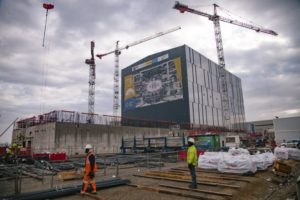A work with 128 tubes, many green and travertine: here is the new square in via Palermo in Perugia
128 galvanized iron pipes, painted black and mounted on a reinforced concrete base with black epoxy resin surface finish. All wrapped by panels covered with mirrored aluminum sheet that reflect in a fragmentary way the pedestrians and the surrounding urban landscape. It is the sculptural
work conceived by the designer Fabrizio Milesi, who will stand at the center of the new square in via Palermo in Perugia, which will probably be ready at the end of 2019. It will be a public space with a lot of travertine, green, a bus stop and seating areas, which will also serve to enhance a little visible
and little known building even if it was realized in the eighties by Bruno Signorini, a Perugian architect among the most important of the twentieth century Italian : it is the headquarters of Confindustria Umbria, an entity that finances the works with an investment of 350 thousand euro out of a total of 500 thousand.




 How to build a “steampunk” route for cats. It is told by www.wired.it, taking up the idea that the architects from the Because We Can studio have developed for a house in San Francisco: retro-style pipes that climb all the walls of the house and entertain cats, allowing them to cross the room without putting a paw on the floor or on the computer keyboard. The tube path, with openings and viewpoints, is constructed of a material called Sonotube, which consists of a cardboard tube coated internally of wax, used in construction for pouring concrete: cheap and easy to cut, it is painted externally with an antique bronze effect paint, to give them the appearance of old industrial metal pipes. Also support rings, fixing hooks to the parts and decorative pieces, made of plywood, must have an industrial look of the structure, to have (in addition to happy cats) a coherent and original original piece of furniture.
How to build a “steampunk” route for cats. It is told by www.wired.it, taking up the idea that the architects from the Because We Can studio have developed for a house in San Francisco: retro-style pipes that climb all the walls of the house and entertain cats, allowing them to cross the room without putting a paw on the floor or on the computer keyboard. The tube path, with openings and viewpoints, is constructed of a material called Sonotube, which consists of a cardboard tube coated internally of wax, used in construction for pouring concrete: cheap and easy to cut, it is painted externally with an antique bronze effect paint, to give them the appearance of old industrial metal pipes. Also support rings, fixing hooks to the parts and decorative pieces, made of plywood, must have an industrial look of the structure, to have (in addition to happy cats) a coherent and original original piece of furniture.
 Sophisticated design and cutting-edge technology are concentrated in the “tube-free hood” Glow Plus, from the Italian company Faber. The hood becomes a real piece of furniture suspended (thanks to thin cables) on the hob, with lighting and suction controlled by remote control; thanks to the new Airlane technology, the suspended appliance sucks in the fumes and steam, while a second engine positioned in the ceiling creates an air cone that channels the smells upwards. The two engines then create a sort of “invisible pipe” that pushes the fumes outwards.
Sophisticated design and cutting-edge technology are concentrated in the “tube-free hood” Glow Plus, from the Italian company Faber. The hood becomes a real piece of furniture suspended (thanks to thin cables) on the hob, with lighting and suction controlled by remote control; thanks to the new Airlane technology, the suspended appliance sucks in the fumes and steam, while a second engine positioned in the ceiling creates an air cone that channels the smells upwards. The two engines then create a sort of “invisible pipe” that pushes the fumes outwards.
 It weighs 5 quintals concentrated in eight almost two meters long copper alloy tubes, covered with tungsten blocks, a material with a high melting point, excellent thermal conductivity and high strength. It is the Inner Vertical Target, a “made in Italy” project created by ENEA and Ansaldo Nucleare. It is one of the three components of the ITER fun, the great reactor for nuclear fusion research under construction in the South of France.
It weighs 5 quintals concentrated in eight almost two meters long copper alloy tubes, covered with tungsten blocks, a material with a high melting point, excellent thermal conductivity and high strength. It is the Inner Vertical Target, a “made in Italy” project created by ENEA and Ansaldo Nucleare. It is one of the three components of the ITER fun, the great reactor for nuclear fusion research under construction in the South of France.